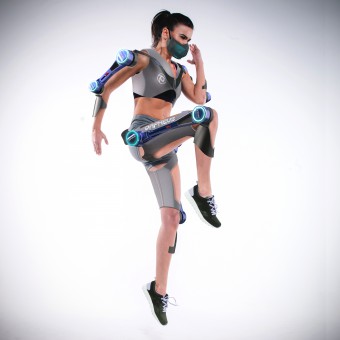
| THE AWARD |
| CATEGORIES |
| REGISTRATION |
| SUBMIT YOUR WORK |
| ENTRY INSTRUCTIONS |
| TERMS & CONDITIONS |
| PUBLICATIONS |
| DATES & FEES |
| METHODOLOGY |
| CONTACT |
| WINNERS |
| PRESS ROOM |
| GET INVOLVED |
| DESIGN PRIZE |
| DESIGN STORE |
| THE AWARD | JURY | CATEGORIES | REGISTRATION | PRESS | WINNERS | PUBLICATIONS | ENTRY INSTRUCTIONS |
Orpheus Exoskeletal Exercise Device by Mehmet E. Ergül |
Home > Winners > Design #54239 >Interview |
 |
|
FS: What is the main principle, idea and inspiration behind your design?
ME: In outer space, the only pivot point is our own body. So the products should have a harmony with the human body itself. The main inspiration was Aerial Dancers and Ballets, their forms and body positions while dancing are very similar to the moves of the astronauts in orbit. For achieving the perfect product/user relationship ergonomics wise, exoskeletons inspired the design by form and technology.
FS: What has been your main focus in designing this work? Especially what did you want to achieve?
ME: As an industrial designer, we design products for human beeings and living organisms of course. But when we think about space and space industry, almost none of the designers worked or done succesful projects for this industry. Astronauts need also some betterly designed products; their tasks and daily routines takes so much effort and making those things at the orbit is an extremely difficult task. With Orpheus, I wanted to focus on those aspects and create an awareness.
FS: What are your future plans for this award winning design?
ME: Creating more connections with the companies in the space industry will be the key as a future plan.
FS: How long did it take you to design this particular concept?
ME: The whole process; from scratch to this concept design took approximately 9 moths. Rather than designing only a product, several articles and patents were also achieved during the design process.
FS: What made you design this particular type of work?
ME: Designing a product for the space industry were always my dream, actually my childhood dream. Since my childhood I always wondered about space and the equipments so designing this prıduct was a very emotional and both motivational process for me.
FS: Who is the target customer for his design?
ME: The Orpheus is at the end an exercise device which we can wear to our body. Rather than the space industry and the astronouts, any exercise needed profession can benefit from this concept. Physiotheraphy, fitness industry, health equipments and the companies which work for those industries can be the target for this particular design.
FS: What sets this design apart from other similar or resembling concepts?
ME: When we look at the exoskeletons in general, they are always "helping" to the human body for a reason. This might be a product for a paralysed person or an assistant for a heavy-duty worker. Orpheus stands out from other products in this sense. When we look closely, it is not helping the human body, it is actually "forcing" the body physically. For making an exercise or a move, you need to push your muscles and bones so the product differs from other concepts in that way.
FS: How did you come up with the name for this design? What does it mean?
ME: Orpheus is the short name of "Orbital Parametric Exercise Equipment for Spacecrafts". It also has a mhytological meaning and is a strong word emotionally which can reflect the inner ideology of the product.
FS: What is the role of technology in this particular design?
ME: Technology is the key element for this design. Making the product tailored for the user, adaptive joints, the software background needs several technologies which developed in the past decade.
FS: Is your design influenced by data or analytical research in any way? What kind of research did you conduct for making this design?
ME: Orpheus evolved with analytical datas and researches, so the products background is very strong in that sense. Lots of articles and datas has been analysed in the design process, also several questionaires has been made with the professionals in space industry and fitness industry.
FS: What are some of the challenges you faced during the design/realization of your concept?
ME: Designing a product for space is by itself a difficult task, since there are lots of rules and regulations for anything. Also collecting the datas were sometimes a hard approach since most of the patents, datas are government secrets for any country.
FS: How did you decide to submit your design to an international design competition?
ME: For making the product famous and known, an international design award was a very important phase for this project. I am very happy that the design won a precious award level.
FS: Thank you for providing us with this opportunity to interview you.
A' Design Award and Competitions grants rights to press members and bloggers to use parts of this interview. This interview is provided as it is; DesignPRWire and A' Design Award and Competitions cannot be held responsible for the answers given by participating designers.
| SOCIAL |
| + Add to Likes / Favorites | Send to My Email | Comment | View Press-Release |





